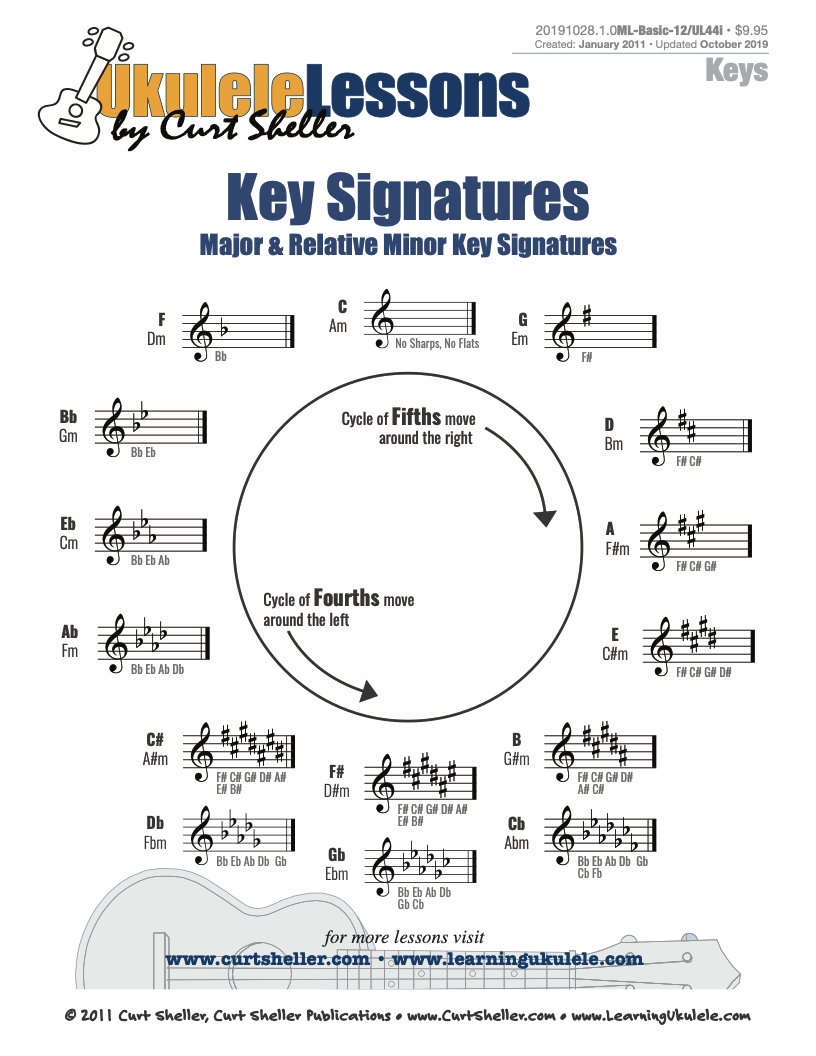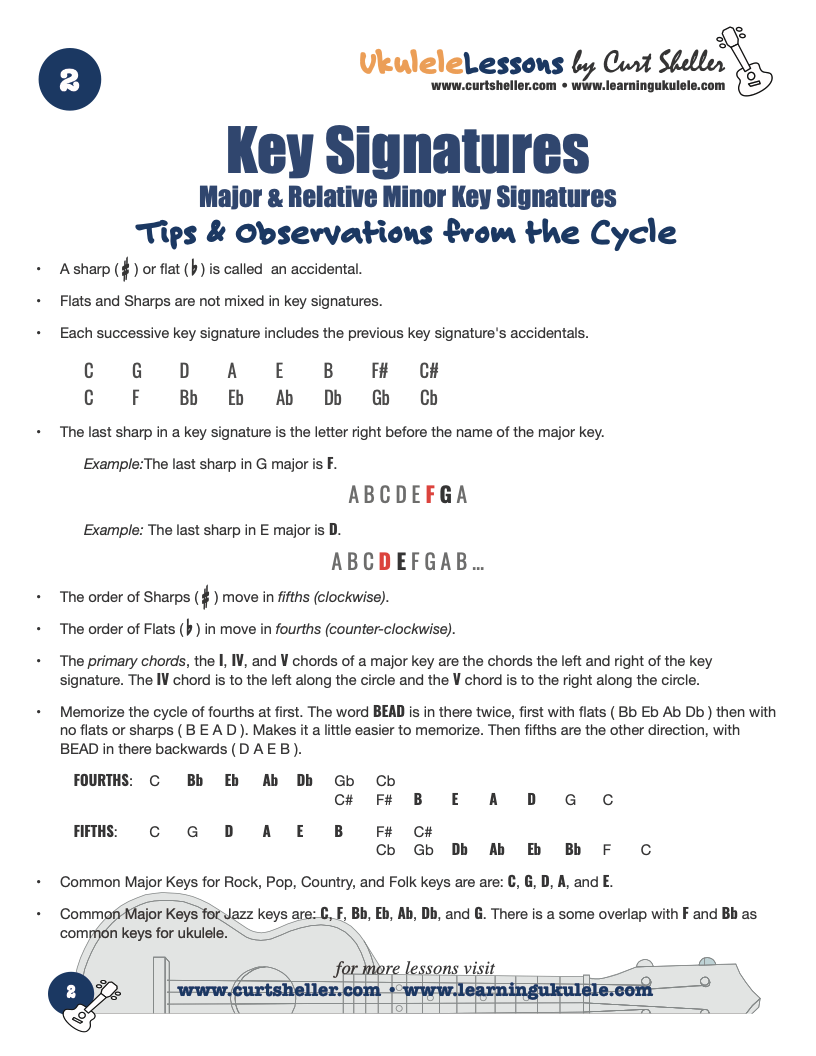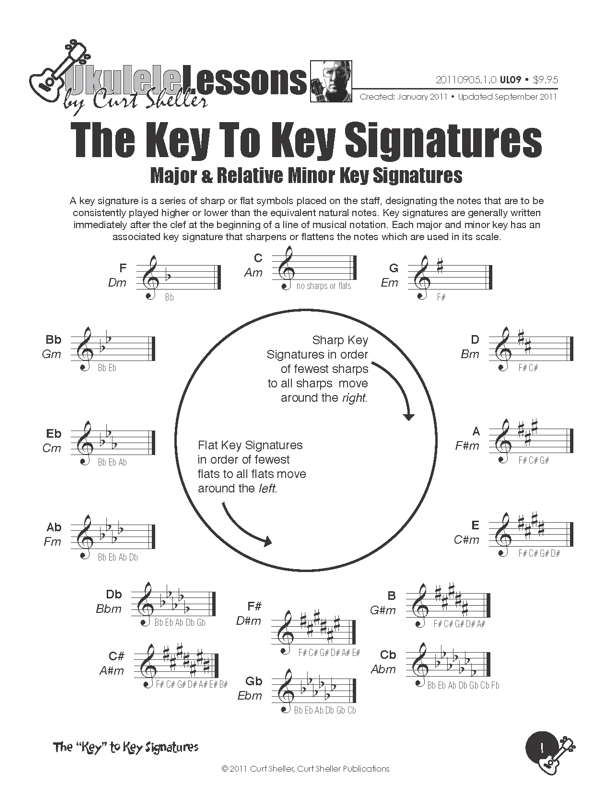Traditional key signatures provide a wealth of information that can enhance our understanding of music and its underlying principles.




Traditional Key Signatures provide a wealth of information that can enhance our understanding of music and its underlying principles.
A Key Signature consists of a set of sharp( ♯) or flat (♭) symbols placed on the staff, indicating the specific notes that are consistently played higher or lower than the natural notes. Key signatures are typically positioned right after the clef at the beginning of a musical notation line. Each major and minor key is associated with a unique key signature that alters certain notes within its scale.
By recognizing and interpreting key signatures, musicians can quickly identify the tonal center and harmonic framework of a piece of music. The key signature helps establish the set of notes and intervals that form the foundation of melodies, chords, and progressions within a given key. Understanding key signatures allows musicians to anticipate and navigate the altered pitches in a musical composition, enabling them to play with accuracy and confidence.
A Few Observations
- 15 Diatonic Keys • NOT 12 • If considering the Relative Minor keys of the Major Keys—the total is 30.
- Key of C Major / A Natural Minor contains only all natural notes: C D E F G A B C'
- Seven Sharp Keys: G D A B F♯ C♯
- Seven Flat Keys: F B♭ E♭ A♭ D♭ G♭ C♭
- Key of C♯; has ALL sharps: C♯ D♯ E♯ F♯ G♯ A♯ B♯ C♯'
- Key of C♭ has ALL flats: C♭ D♭ E♭ F♭ G♭ A♭ B♭ C♭'
- Flats (♭) and Sharps (♯) are not mixed in Major and Relative Minor keys Key Signatures
- Each successive Key Signatures includes the previous key signature's accidentals.
- The last sharp (♯) in a key signature is the letter right before the name of the major key. Example: The last sharp in G major is F♯. A B C D E F♯ G. The last sharp in E major is D♯ • A B C D♯ E F G A.
- The second to last flat (♭) in a key signature is the name of the major key. Example: The second to last flat in D♭ major is D♭. B♭ E♭ A♭ D♭ G♭. There is only one flat in F major and no second to last works —you just have to memorize that one.
- The order of Sharps move in fifths (clockwise F♯ C♯ G♯ D♯ A♯ B♯ ). The order of Flats move in fourths (counter-clockwise B♭ E♭ A♭ D♭ G♭ C♭ F♭).
Traditional Key Signatures provide a wealth of information that can enhance our understanding of music and its underlying principles.
A Key Signature consists of a set of sharp( ♯) or flat (♭) symbols placed on the staff, indicating the specific notes that are consistently played higher or lower than the natural notes. Key signatures are typically positioned right after the clef at the beginning of a musical notation line. Each major and minor key is associated with a unique key signature that alters certain notes within its scale.
By recognizing and interpreting key signatures, musicians can quickly identify the tonal center and harmonic framework of a piece of music. The key signature helps establish the set of notes and intervals that form the foundation of melodies, chords, and progressions within a given key. Understanding key signatures allows musicians to anticipate and navigate the altered pitches in a musical composition, enabling them to play with accuracy and confidence.
A Few Observations
- 15 Diatonic Keys • NOT 12 • If considering the Relative Minor keys of the Major Keys—the total is 30.
- Key of C Major / A Natural Minor contains only all natural notes: C D E F G A B C'
- Seven Sharp Keys: G D A B F♯ C♯
- Seven Flat Keys: F B♭ E♭ A♭ D♭ G♭ C♭
- Key of C♯; has ALL sharps: C♯ D♯ E♯ F♯ G♯ A♯ B♯ C♯'
- Key of C♭ has ALL flats: C♭ D♭ E♭ F♭ G♭ A♭ B♭ C♭'
- Flats (♭) and Sharps (♯) are not mixed in Major and Relative Minor keys Key Signatures
- Each successive Key Signatures includes the previous key signature's accidentals.
- The last sharp (♯) in a key signature is the letter right before the name of the major key. Example: The last sharp in G major is F♯. A B C D E F♯ G. The last sharp in E major is D♯ • A B C D♯ E F G A.
- The second to last flat (♭) in a key signature is the name of the major key. Example: The second to last flat in D♭ major is D♭. B♭ E♭ A♭ D♭ G♭. There is only one flat in F major and no second to last works —you just have to memorize that one.
- The order of Sharps move in fifths (clockwise F♯ C♯ G♯ D♯ A♯ B♯ ). The order of Flats move in fourths (counter-clockwise B♭ E♭ A♭ D♭ G♭ C♭ F♭).
Key Signatures and the Circle of Fifths and Fourths
- Memorize the cycle of fourths at first. FOURTHS: C F B♭ E♭ A♭ D♭ F♯ B E A D G C. The word BEAD is in there twice, first with flats( B♭ E♭ A♭ D♭ ) then with no flats or sharps ( B E A D ). Making it a little easier to memorize. Then fifths is the other direction, with BEAD in there backwards ( D A E B ).
- The Primary Chords for a Major Key are: to left (the IV chord) and the right (the V chord) of the root of the key (the I chord). This ONLY works for major keys and not their Relative Minor keys.
Fourths: C F B♭ E♭ A♭ D♭ F♯ B E A D G C
Fifths: C G D A E B F♯ D♭ E♭ A♭ ♭b F C
- A sharp (♯) and flat (♭) are two of the three accidentals with a natural sign (♮) being the other. Other than the Key of C Major/Am the cycle is full of either sharps or flats and not any mixed with sharps and flats.
- Common Rock, Pop, Country, and Folk keys are: C, G, D, A, and E. These are typical keys for guitar.
- Common Jazz keys are: C, F, B♭, E♭, A♭, D♭, and the lone sharp key of G. There is a some overlap with F and Bb as common keys for ukulele.
- For each key there is a corresponding lesson covering the primary, secondary, and diminished chords in each major key. See the Key Signatures Lessons Series .
-
The answer the the questions?
How many traditional major and minor keys are there?
Is 30 — the 15 major and 15 relative minor keys.
The Circle of Fifths Made Clear by Mark Newman
Great video explaining the history and significance of learning this mystical, musical key.
Memorize IT!
I actually memorized the sequence C F Bb Eb Ab Db F# B E A D G (C), With out resorting to any mnemonics by seeing that there is the word BEAD in there twice. Once with flats and once natural notes.
In this order it is actually in the counter-clockwise order and a cycle of fourths - not fifths.
First: As a Cycle of Fourths
- Memorize C and F
- BEAD with flats for Bb Eb Ab Db
- The transition F# or Gb it's Enharmonic Equivalent then
- BEAD and finally
- G C
for: C F Bb Eb Ab Db F# B E A D G C
Second: As a Cycle of Fifths
Then backwards as the Circle of Fifths.
Additional Resources & Links
- Leonard Bernstein (The Unanswered Question): Bernstein, The greatest 5 min. in music education.
- The Harmonic Series
Related Lessons, Videos, Lesson Series, Songs, Books & Reference Charts, Resources & Assets, Workshops are below.

A "Key Signature" is a series of sharp or flat symbols placed on the staff, designating the notes that are to be consistently played higher or lower than the equivalent natural notes. Key signatures are generally written immediately after the clef at the beginning of a line of musical notation. Each major and minor key has an associated key signature that sharpens or flattens the notes which are used in its scale.
Key Signatures and the Circle of Fifths and Fourths.

Harmonic Analysis is the understanding of the functional sequence of chords. It is the process used to analyze the harmonic structure of a progression, song or composition. This analysis is then used to make scale selections for improvisation and chord substitution.

Finally, learn the names of the notes of the ukulele fingerboard in C tuning .

Learn the six fingering principles to navigating the ukulele fingerboard. Fingering is one of the most universal topics. Book: Six Secrets of the Ukulele Fingering

Harmonic Analysis is the understanding of the functional sequence of chords. It is the process used to analyze the harmonic structure of a progression, song or composition. Book: Harmonic Analysis for Scale Selection and Chord Substitution

Learn to read single note melodies in the first/open position is a lot easier than you might think. Book: Ukulele – Reading Music Series – Primer

An organized collection of daily practice and reference material for the contemporary ukulele player for developing the vocabulary and knowledge necessary for single note playing. Book: Daily Practice Material for the Contemporary Ukulele
Checkout the Books & Reference Charts for additional Handy, Dandy Reference Charts.

Ukulele Fingerboard Chart for C Tuning, Low or High G – G C E A

Ukulele Fingerboard Chart for G Tuning, Low or High A – D G B E

A handy reference chart of all 15 major and relative minor key signatures. US Letter 8.5 x 11 sized (ANSI-A), A4
Checkout the Books & Reference Charts for additional Handy, Dandy Reference Charts.




















.jpg)